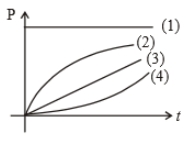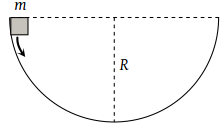The bob of a pendulum of length l is pulled aside from its equilibrium position through an angle and then released. The bob will then pass through its equilibrium position with a speed v, where v equals
(1)
(2)
(3)
(4)
A spring 40 mm long is stretched by the application of force. If 10 N force is required to stretch the spring through 1 mm, then work done to stretch the spring 40 mm is equal to:
| 1. | 84 J | 2. | 68 J |
| 3. | 23 J | 4. | 8 J |
Two springs with spring constants = 1500 N/m and = 3000 N/m are stretched by the same force. The ratio of potential energy stored in the springs will be
1. 2:1
2. 1:2
3. 4:1
4. 1:4
A block of mass \(2~\text{kg}\) moving with a velocity of \(10~\text{m/s}\) on a smooth surface hits a spring of force constant \(80\times10^3~\text{N/m}\) as shown in the figure. The maximum compression in the spring will be:

1. \(5~\text{cm}\)
2. \(10~\text{cm}\)
3. \(15~\text{cm}\)
4. \(20~\text{cm}\)
A particle of mass 10 kg is moving with velocity of m/s, where x is displacement . The work done by net force during the displacement of particle form x = 4 to x = 9 m is
1. 1250 J
2. 1000 J
3. 3500 J
4. 2500 J
The relation between velocity (v) and time (t) is , then which one of the following quantity is constant:
1. Force
2. Power
3. Momentum
4. Kinetic Energy
A particle is moving on the circular path of the radius (R) with centripetal acceleration . Then the correct relation showing power (P) delivered by net force versus time (t) is

1. 1
2. 2
3. 3
4. 4
1. \(\frac{4}{3}~\text{J}\)
2. \(\frac{5}{6}~\text{J}\)
3. \(\frac{3}{2}~\text{J}\)
4. \(\frac{7}{5}~\text{J}\)
A force F is applied on a body which moves with a velocity v in the direction of the force, then the power will be
1.
2. Fv
3.
4. F/v
A mass m slips along the wall of a semispherical surface of radius R. The velocity at the bottom of the surface is [ MP PMT 1993]

(1)
(2)
(3)
(4)






